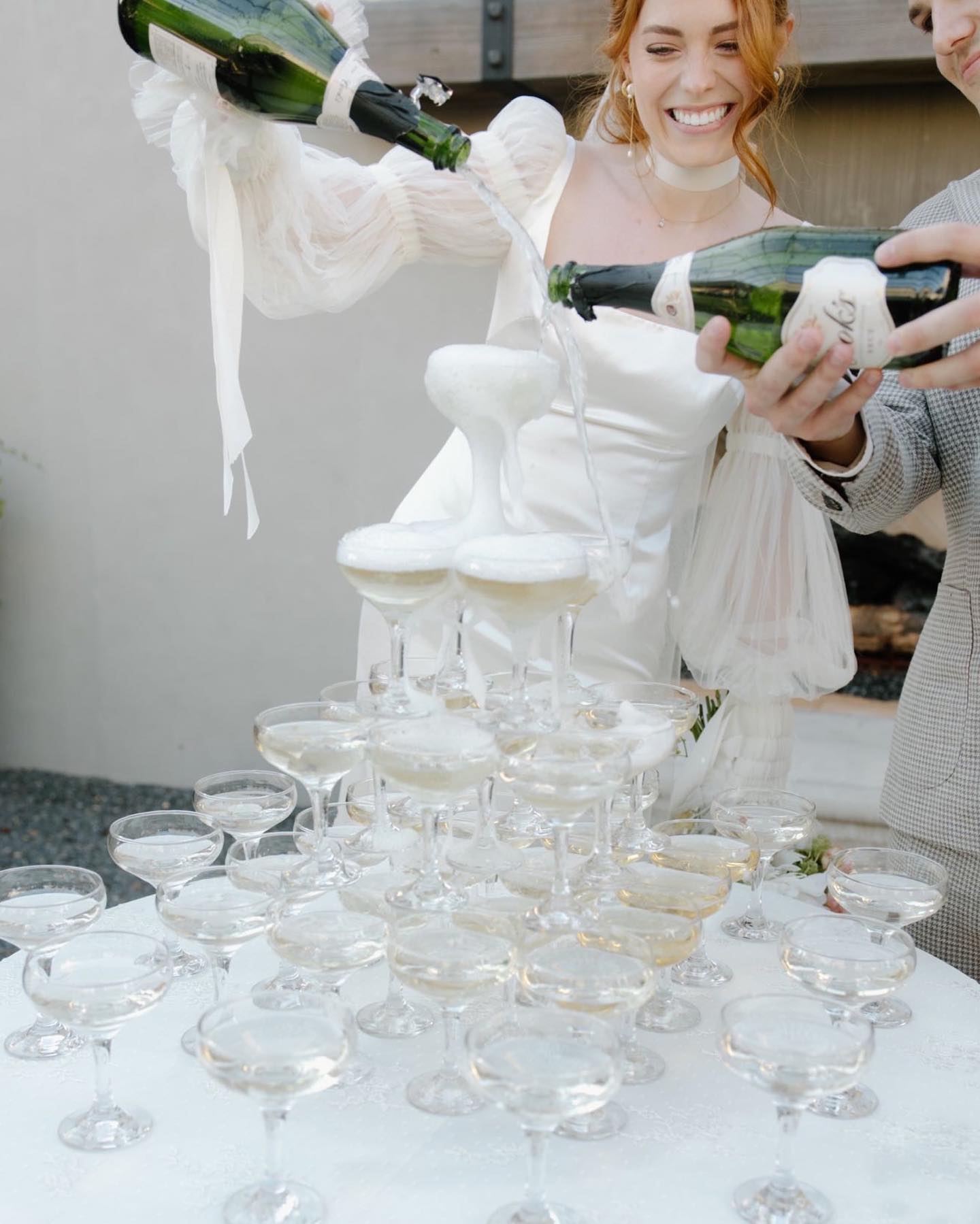When it comes to wedding etiquette and planning, countless questions come to mind. When do you send invitations? Who do you invite? What is an acceptable gift value?
Minted has written dozens of articles on these topics, but we wanted to put everything in one wedding etiquette guide. So, this article will cover everything from what to wear to what the mother-of-the-groom should be doing…and answers some of the top wedding etiquette questions we get all the time!
Wedding Etiquette for The Bride and Groom
You’re ready to tie the knot — congratulations! This is a warm, fuzzy time for you, but you might feel a little overwhelmed. After all, a wedding isn’t just the reception.
You’ll have to manage invitations, seating arrangements, and more for the ceremony, reception, rehearsal dinner, and engagement party (if you’re choosing to have one). And everything on that list comes with proper wedding etiquette expectations.
Let’s start with wedding etiquette for engagements.
Engagement Etiquette
Getting engaged comes with a lot of excitement—and a few early decisions to think through. From sharing the news to chatting about budgets and guest lists, this is the starting line for everything ahead.
1. Don’t post on social media the day of your proposal
Maybe you planned a photographer to capture your proposal. It’s a beautiful memory, and we promise you can share it — but fight the urge to post on Instagram immediately.
Your closest family and friends will want to hear the good news from you and your beau first! So send a quick text, make a few calls, or visit in person first and then start playing with dreamy filters.
To make it more special, you can send an engagement announcement card to your close circles using those beautiful photos! Breaking the news on social media with lovely quotes and captions is usually the last thing to do because it is less personal.
2. Start talking budgets
It’s time to discuss your wedding budget. Don’t worry — talking about it early doesn’t break any wedding etiquette. In fact, delaying the conversation almost assures chaos later. You might even choose to plan your budget before an engagement and that’s also great! While talking about budgets, you might need to go back and forth to determine how many people you should or can invite to your wedding.
Traditionally, the bride and her family were responsible for covering the wedding. Today, that tradition is no longer fair or realistic. The couple should sit with their families and discuss budget allocations transparently to avoid any issues.
Need a starting point? Here are some budget allocations that some modern couples employ:
Groom and family:
- Accommodations for the bride, groom, and wedding party (even for destination weddings)
- Bouquets and corsages
- Rehearsal dinner
- Wedding rings
- Marriage certificate
- Groomsmen suits (though many modern couples have the wedding party pay for this now)
Bride and family:
- Accommodations for the bride’s party
- Wedding reception, including food, drinks, venue, videographer, photographer, and decorations
- Stationery and invitations
- Wedding transportation
3. Propose…to your bridal party
After your engagement, it’s easy to jump on the phone and gush to a good friend. You might let it slip that you’d like them to be your best man or maid of honor.
Our advice? Hold back just a bit longer. When you’re planning your budget and guest list, you might have a different bridal party than you originally thought. Take a month or so to decide on your bridal party, so you don't make any empty promises.
Once you have your list, show your bridal party respect by respectfully requesting their presence. Avoid a boring social media message. Instead, check out these adorable “Will you be my bridesmaid” cards and consider including a cute personalized gift.
If you don’t include a gift when you ask them to be part of your bridal party, you may consider giving one on the day of the event. After all, they’ve given a lot of time and effort to make your day special. Choose something that they can treasure long after the wedding.
Alternatively, you may decide you don’t want a wedding party. Traditionally, the wedding party helps arrange the wedding shower and bachelor/bachelorette parties. If you’re planning on still having these events, then you’ll have to plan them yourself or enlist the help of friends and family.
While we’re on the topic of wedding showers, a big faux pas is to invite friends to the wedding shower who aren’t invited to the wedding. This is an insensitive move that could cost friendships – don’t do it.
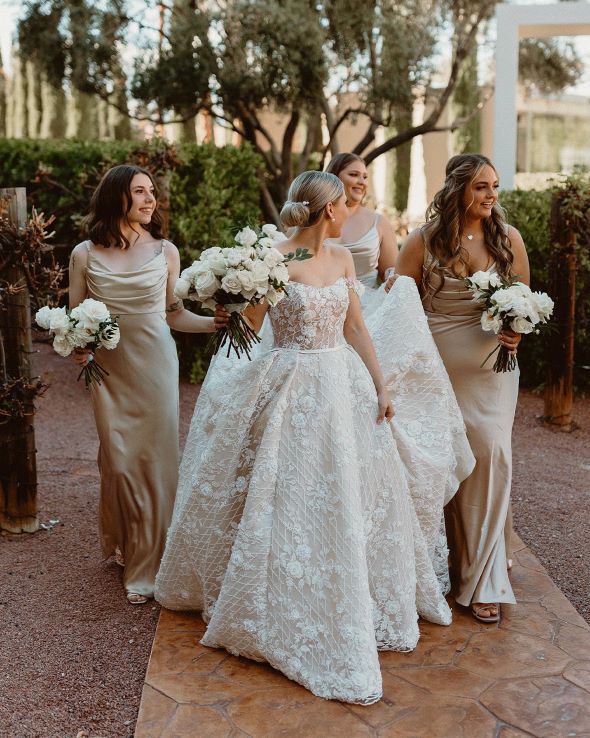
Photo by Howie Photography
4. Engagement party do’s and don’ts
Traditionally, wedding etiquette has the bride’s parents hosting the engagement party. If they’re not game, then you can go to the groom’s parents.
But these days, brides and grooms often host it on their own or with friends — this is perfectly acceptable as long as you let everyone know.
Here are some quick do’s and don’ts for the party:
- Don’t invite people who you won’t invite to the wedding.
- Don’t request gifts – though know you’ll probably get some anyway. If so, make sure to send out thank you notes right after.
- Do make introductions. Some of your guests might not know each other, so help them have a good time.
- Do thank your guests for coming! A handwritten thank you is the most appropriate wedding etiquette, but a carefully thought out, illustrated email is acceptable too.
- Do treat the hosts if it’s not you and your partner. A nice bottle of alcohol or a dinner out is in order for your hardworking hosts.
Wedding Invitation Etiquette
Sending invitations isn’t just about picking something pretty. This is where you set the tone and get everyone the details they need. From who’s invited to how to word it all, we’ll help you keep it simple and clear.
5. Send a Save the Date
Think of this as your pre-wedding invitation. Your beloved guests need a heads-up for your engagement party, wedding ceremony, and other pre-wedding events. Send your save the date cards about six to eight months before the wedding.
But don’t ask for an RSVP! Save the dates are a courtesy for your guests and aren't as formal as a wedding invitation. However, feel free to embellish with details and design. That being said, some guests might tell you whether they can or can’t come to the wedding just after receiving your save the date. Regardless of any initial response to your save the date, you should send the wedding invitations to all guests on your save the date recipient list.
6. Decide on plus ones
Ah, the age-old debate of wedding invitation plus one etiquette. The truth is, there’s no golden rule for this aspect. The bride and groom just need to be absolutely clear about their preference in the wedding invitation.
At Minted, our stance is that married, engaged, cohabitating and long-term couples should get a plus one. Also, the bridal party is allowed to bring their plus one. For everyone else, we suggest a blanket rule, i.e., only immediate family can bring a plus one.
You do have a few options:
- Plus ones for every guest
- Plus ones for guests that are married or in serious relationships
- Plus ones for guests of whom you’ve met their partner
- Plus ones for the bridal party
- Plus ones for immediate family
- No plus ones at all
Whatever you decide, ensure you indicate whether a guest gets a plus one by listing it on their invitation. They can then mark the response card appropriately.
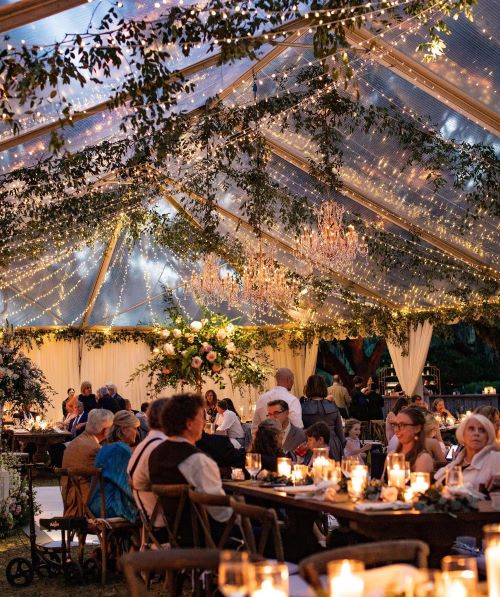
Photo by Christiana Collective
7. The Rehearsal Dinner is not mandatory
Having a rehearsal dinner isn’t required, though it can be a really nice way for family and the wedding party to socialize and get to know one another more intimately before your big day. It also doesn’t need to be an actual dinner. It could be a breakfast, brunch, lunch, or even a happy hour. Traditionally, the groom’s parents, or those that are not paying for the bulk of the wedding, pay for the rehearsal dinner, but these days more couples are paying for their own rehearsal dinners (and weddings).
Check out Minted’s complete guide to rehearsal dinner etiquette for more info.
8. Send thoughtful, clear wedding invitations
Send your invitations eight weeks in advance. The main invitation should include time, location, dress code, and guest details. Include a clear RSVP instruction – through a response card or online RSVP on the website. If you prefer the traditional RSVP response card to be mailed back to you, make sure you include a stamped envelope with your address in each invitation suite. If you are expecting RSVP to be done online, include your website address and password (for password-protected websites). You can also simply include a QR code in your invitation suite. Ask your guests to fill out any dietary restrictions together with the RSVP response.
For a complete breakdown of wedding invitation etiquette, make sure to check our article about Wedding Invitation Wording and Etiquette.
Wedding Website Etiquette
Your wedding website is one of the most useful wedding planning tools you’ve got. It keeps guests informed, answers the most common questions, and makes the whole planning process smoother for everyone. If you haven’t created your website yet, Minted makes it easy to create a wedding website beautifully designed to match your overall wedding vibe.
9. Don’t skip these important points on your website
Let’s be real—your wedding website is basically the hub for all things Big Day. From the dress code to hotel blocks to your registry, this is where guests go when they have questions (and trust us, they will). Here are some points you should definitely cover on your website:
- The schedule: Ceremony start time, reception details, shuttle service info, and any pre-wedding events.
- Hotel block: Share booking details, deadlines, and links for easy reservations.
- Dress code: Be specific to avoid confusion (i.e., "cocktail attire" or "beach formal").
- Registry info: Your website is the place for registry links, we recommend including them here instead of on your wedding invitation itself.
10. Decide early on how you want to share your website
Some couples choose to list their wedding website directly on the invitation, while others prefer to share it on a separate details card or digitally. Since these cards need to go out for printing in advance, take care to decide how you want to share it.
There’s no one-size-fits-all answer—just consider what makes the most sense for your wedding style and what will be easiest for your guests.
- Best practice: Include your website on a separate details card or share it digitally via your save the date or email.
- Pros of including it on the invite: It's budget-friendly if you’re skipping extra insert cards, and it puts everything in one place for your guests.
- Cons: If you're also including RSVP or registry cards, too much info might overwhelm or confuse guests. It can also feel less traditional if you're aiming for a formal tone.
Our take? Do what makes the most sense for your wedding style and guests—just be thoughtful and clear.
Pro Tip: Want to keep your wedding info for VIP eyes only? Consider password-protecting your website and sharing the login info on your Save the Date or via email. It keeps things personal and gives you peace of mind.
Wedding Ceremony Etiquette
Your ceremony is kind of a big deal. It’s the part everyone’s been waiting for, and it deserves just as much love and planning as the party that follows.
The order of events on your big day also heavily depends on the type of venue you’re finalizing. To better understand this, you can go through our ready guide that walks you through planning the perfect timeline for your big day.
In the meantime, here are just a few tips to get you started!
11. Walking down the aisle with your dad is optional
While it is tradition for the father of the bride to walk the bride down the aisle, it is by no means necessary. In fact, today it is not unusual for brides to walk themselves down the aisle. In other cases, brides are opting to have someone else give them away. Think mother, grandfather, brother, son, or best friend.
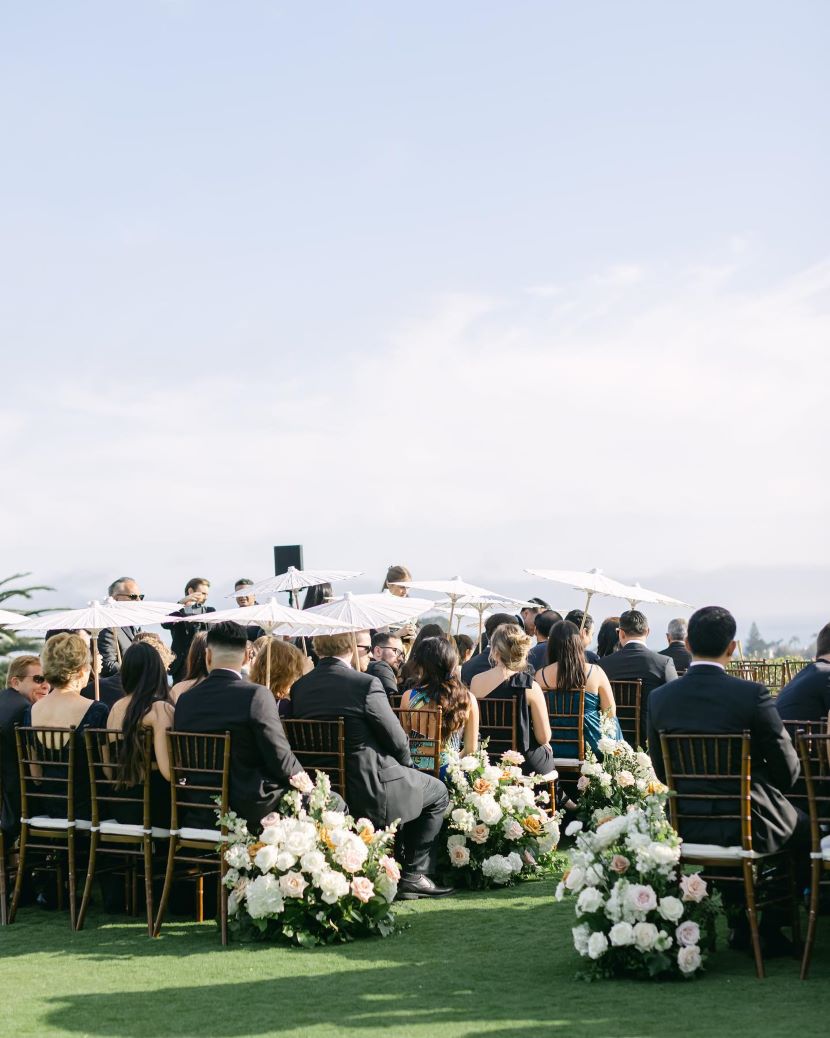
Photo by Aura Elizabeth Photo
12. Create, communicate, and rehearse with your wedding party and parents regarding the procession and recession
Wedding parties typically walk in a specific order on ceremony day, which is:
- Bride’s mother
- Groom
- Best man
- Flower girl
- Ring bearer
- Bride accompanied by her father
If the father of the bride is walking with the bride, then who does the mother of the bride get accompanied by? Good question! There are several options, the most traditional being one of the groomsmen. If it is more fitting, have one of her sons walk her down the aisle. Another good choice is her brother.
There are also slight variations when it comes to the recessional order, but you’ll be in line with traditional etiquette if you stick loosely to the below breakdown.
- The Couple
- Flower Girl and Ring Bearer
- Maid or Matron of Honor and Best Man
- Bridesmaids/Groomsmen
- Parents of the Bride
- Parents of the Groom
- Grandparents of the Bride
- Grandparents of the Groom
Make sure to go over this in the rehearsal or triple-confirm the order with everyone before the ceremony on the big day.
13. Create and communicate the ceremony order
Please don’t try to wing your wedding ceremony! It might sound fun, but it can turn into a nightmare on the day itself. Make sure your guests know what to expect. Plan out your seating chart, schedule, processional, vows, and more with our complete wedding ceremony guide.
14. Create thoughtful vows
Take time to create meaningful vows before the ceremony. Don’t rely on over-the-top cliches or copy movie vows. And let’s set the record straight: inappropriate jokes during your vows are a wedding etiquette faux-pas! (For help writing your vows, check out our complete guide!)
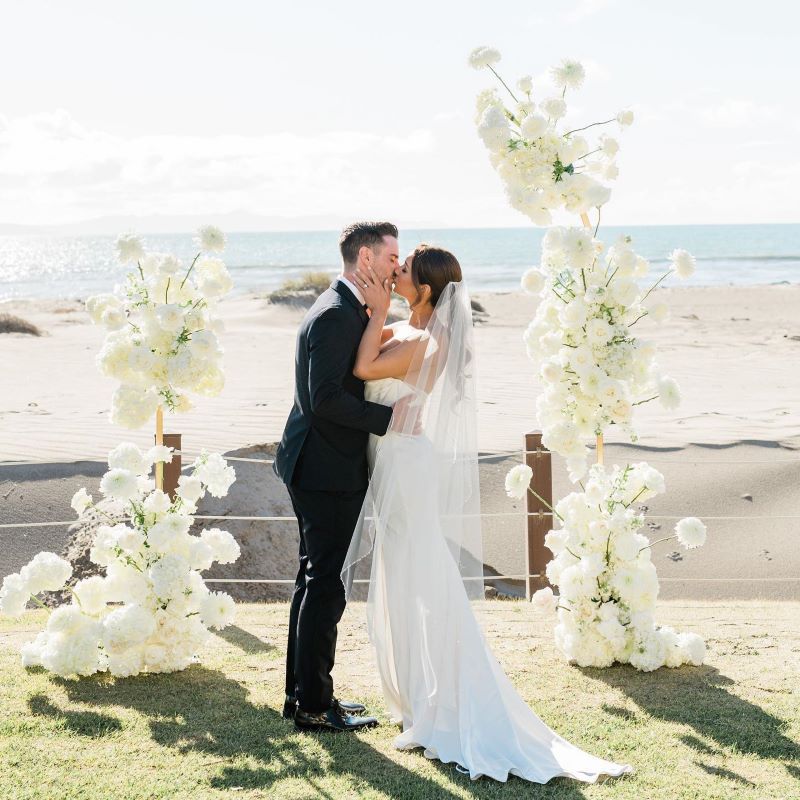
Photo by Lillian Rose Photography
15. Seating arrangements during the ceremony
Traditionally, the family of the bride sits on the left side and the groom’s family on the right. However, this depends on the number of guests present and the seating available.
Parents typically sit in the front row of each side, along with the members of the wedding procession (bridal party, ring bearer, flower girls, readers, etc.). Grandparents, other family members, and close friends sit behind that group in the succeeding rows.
16. Personalize within reason
Custom vows? A song that means something to you both? A symbolic ritual? Absolutely, go for it. Just try to keep things to around 30 minutes—long enough to be meaningful and short enough that guests stay engaged.
If you’re weaving in cultural or religious traditions, add a quick explanation to your program or have your officiant offer some context during the ceremony. It makes everyone feel included and helps guests connect to the moment—even if it’s something they haven’t seen before.
17. Communicate social media boundaries clearly
If you'd rather not have your vows (or your walk down the aisle) popping up on Instagram before you've even said "I do," it’s totally fair to set some social media boundaries. Start by dropping a quick note on your wedding website—let people know if you’re going unplugged for the whole day or just the ceremony.
At the venue, a friendly, well-designed sign can be a simple way to remind guests to stay present and save the photos for later. And for good measure, have your officiant give a gentle heads-up before everything starts. A quick announcement can go a long way in keeping your ceremony distraction-free.
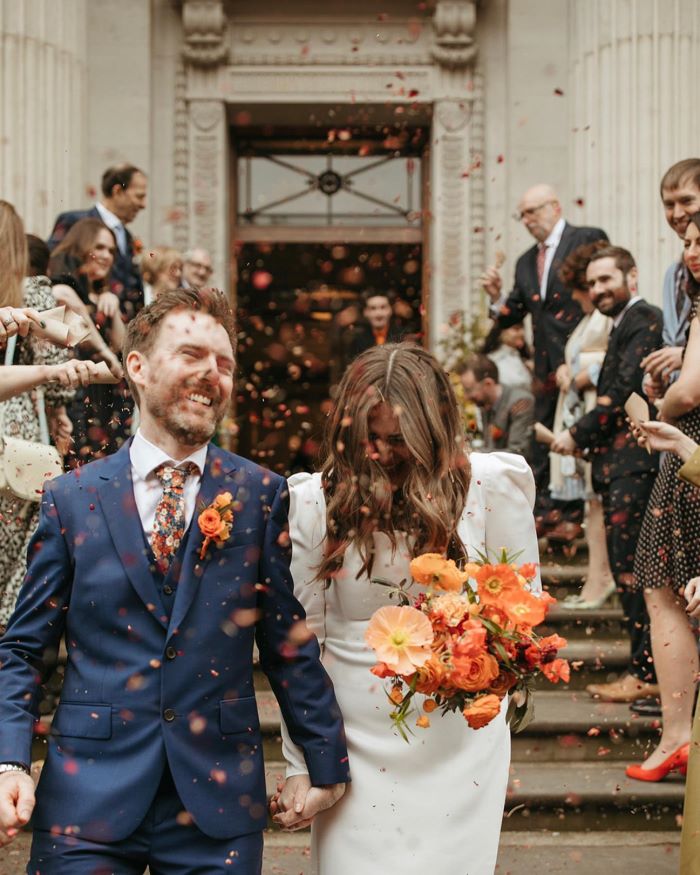
Photo by Alba Turnbull
Wedding Reception Etiquette
Once the "I dos" are done, it’s time to celebrate! But there are still a few things to keep in mind. These tips help make sure the reception flows, everyone’s comfortable, and the couple gets to enjoy every moment.
18. Drink slowly and don’t forget to eat
You’ve been running around all day, probably not eating too much, maybe even taking tons of photos in the hot sun. So while it can be tempting to finish that glass of champagne, prioritizing food and water first before indulging quickly is often smart. Also, make sure to enjoy some food whenever you can.
19. Greet your guests quickly
This is especially true for lengthy weddings. Proper wedding etiquette doesn’t necessarily mean saying hello to every table. Consider a receiving line in the beginning or saying hello to guests organically throughout the night.
20. “First Dance” Comes First
It’s called the “first dance” for a reason! The couple’s first dance is traditionally the first introduction to the dance floor, which is performed by the newlyweds. Wedding reception etiquette is that the father/daughter dance follows, and then the mother/son dance.
21. Don’t put all the singles together at one table
It’s not your job to be a matchmaker! Grouping all of the singles together at one table can make people feel ostracized from the rest of their friends and family. Instead, think about who singles will be most comfortable being seated with. Be kind and intentional — check out our wedding seating FAQs for more details.
22. Feed your vendors and wedding party
Don’t forget to feed your vendors! Some of your team will be working all day to ensure your event runs smoothly. They’ll need to stay nourished and hydrated to keep up the good work. As a rule of thumb, you only need to take care of anyone that is working for both ceremony and reception, such as photographer and videographer, wedding coordinator, DJ/MC, plus their assistants.
Make sure to ask your venue for a room that your vendors can use to eat and coordinate with the catering service on the meal. Don’t forget to ask the vendors about their dietary restrictions and preferred time to eat. This is crucial for them to fit this in the day-of schedule.
You and your wedding party also need to eat before the ceremony. It’s easy to forget food when you’re getting ready for one of the biggest moments of your life, but hydration and nourishment are important.
23. Don’t ask guests to pay for their own drinks
If you’re worried about cost, consider offering a smaller drinks menu; soft drinks, a signature cocktail, beer, and wine.
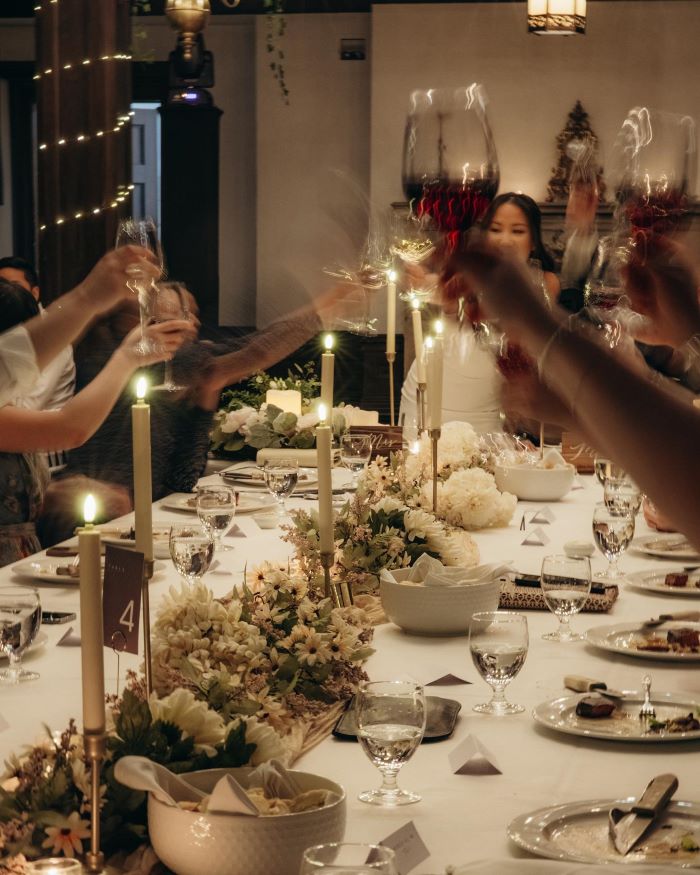
Photo by Francis Fraioli
Post-Wedding Etiquette
The big day may be over, but a few thoughtful follow-ups go a long way. This section covers everything about thank-you notes and simple ways to wrap things up with care.
24. Say Thank You!
The post-wedding thank you card is your opportunity to express your heartfelt gratitude to guests for sharing your special day. Send a card to everyone, regardless of whether they gave a gift or not.
For a truly personal touch, handwrite your thank you notes and customize them to each individual. Recall special moments that you shared with them at the wedding, or thank them for their gift (specify what they gave you), and let them know how much you and your spouse look forward to using it or how much it means to you.
Here are a few more general thank you note etiquette tips:
- If someone sent a gift before the wedding, ensure you send them a thank you note within a couple of weeks.
- For gifts received at the wedding, you have a few months to send one.
- Send a thank you note to your vendors as well.
- Send them while the event is still fresh in your mind, and it’s easier to recall all the special moments you want to make note of. Check out some examples of thank you wording to inspire you.
Etiquette for Wedding Parties
Being in the wedding party comes with a few more responsibilities—but it’s all manageable with a bit of guidance. These tips will help you show up for the couple and enjoy the experience too.
25. Nail the wedding day look
When it comes to what you’re wearing, the couple probably has a vision—that could be a specific color palette, a formal vibe, or just making sure the whole group looks coordinated in photos. Try to stick to what they’ve asked for, even if it’s not totally your style. It’s all about that unified look for the day.
This includes the accessories, too. If they’ve asked for a certain shoe or jewelry, just go with it. It helps the whole group look polished and put together, making the photos pop.
Lastly, if you need to order something or get it altered, don’t wait until the last minute. That’s when shipping delays or tailoring mishaps sneak in, and no one needs that stress right before the wedding.
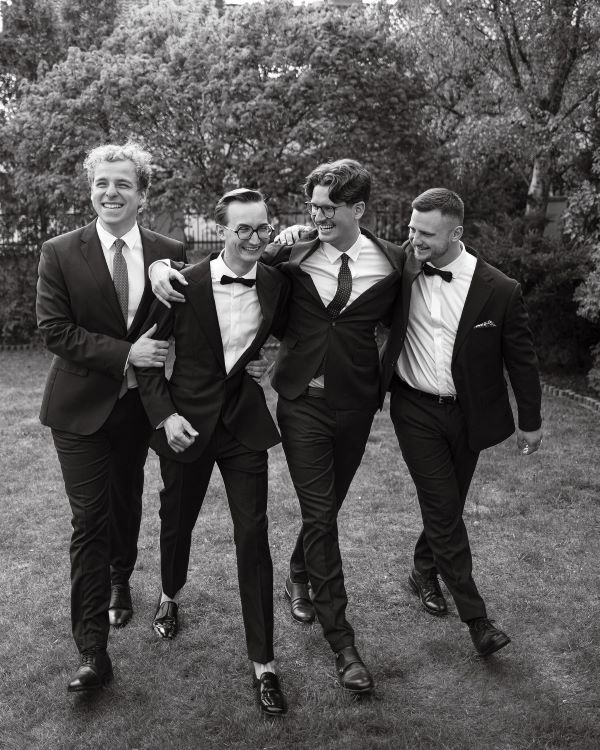
Photo by Maria Dotsenko
26. Sort out your travel and accommodation beforehand
If you’re traveling for the wedding—especially a destination one—book early! Flights and hotel rooms fill up fast, and finding a spot near the venue at the last minute is always a big gamble. Not sure where to stay? Check with the couple—they’ve probably set up a hotel block or can point you to a group rate that’ll save you time (and money).
27. Get a gift to show support
Think of gift-giving as another way to celebrate the couple and show them some love. It doesn’t have to be fancy or expensive, just thoughtful. If you're going solo on a gift, something personal or sentimental always hits the mark. If you have something grand in mind, you could always ask the other wedding party members and create a group to split the budget!
28. Support the newlyweds
The wedding party is a VIP list of people tasked with not only having a good time, but also having the newlywed’s back. Help them prepare for the wedding and be there for them to mitigate any last-minute tasks and issues. Offer to manage the wedding emergency kit, bring water and small bites for the wedding party, or coordinate with wedding vendors.
29. Keep the receiving line moving
Thank guests and place their reception gifts in a designated area. Keep a lively face and encourage the line to keep moving, allowing your bride and groom more time to enjoy the evening.
Etiquette for Wedding Guests
If you’ve been invited to a wedding, there are a few easy ways to be a great guest. From RSVPs to what to wear, here’s how to show up and be thoughtful without overthinking it.
30. Follow wedding invitation instructions
RSVP promptly, and only bring a plus one if the invitation outlines you can. We’ll go more into this below. This also includes following the dress codes.
31. Check the registry early
Check which items your bride and groom requested and do your best to send them to their address before the wedding. Otherwise, a handwritten note and monetary gift are always welcome.
When deciding what gift to give the happy couple, keep a few things in mind:
- There isn’t a hard and fast rule on how much a guest should spend on a wedding gift. The only thing you definitely don’t want to do is spend more than you can afford to!
- If you’re considering a gift for a destination wedding, this is really up to you and your budget.
- You don’t have to purchase a gift off of the couple’s registry, but be sure to take a look at it beforehand to get a sense of the couple’s style.
- If you want to give the couple cash, make sure to include a note so they’re not confused about who it’s from.
32. Follow the dress code
Wedding attire has evolved significantly, but one thing remains constant: the class! The bride and groom should always include the dress code of the wedding on your invitation and wedding website. If you are not sure, you can always confirm with the couple if there are any colors to avoid in particular. In general, as long as you’re dressing to impress, you’ll fulfill all wedding etiquette around attire.
If the wedding is a formal event, there are more concrete expectations around what to wear. Formal attire can include a tuxedo or formal dark suit with a white shirt and a conservative tie, a long dress, pretty separates, or a formal cocktail dress.
Check out our article on everything you need to know about wedding dress codes for a full breakdown of the difference between white tie, black tie, and so much more.
33. Wedding Guest Don’ts
- Don’t bring a plus one without prior approval
- Don’t forget to RSVP and list your dietary restrictions
- Don’t bring a physically large gift to the wedding. Do send it directly to them before the event.
- Don’t be late!
- Don’t wear white, ivory, or other very pale colors that are close to white. Even if a white dress has florals on it, it’s a no-go.
- The bride and groom are off limits before the wedding. Don’t text them on the day of the ceremony.
- Don’t use your cell phone and other mobile devices (including smartwatches) during the ceremony. Be present and don’t
- Don’t obstruct the photographer during the ceremony (and reception) especially if it’s designated as “unplugged.”
- Party hard and have fun, but don’t get too drunk or cause a scene.
- Don’t monopolize the bride and groom.
- Don’t forget to sign the guestbook!
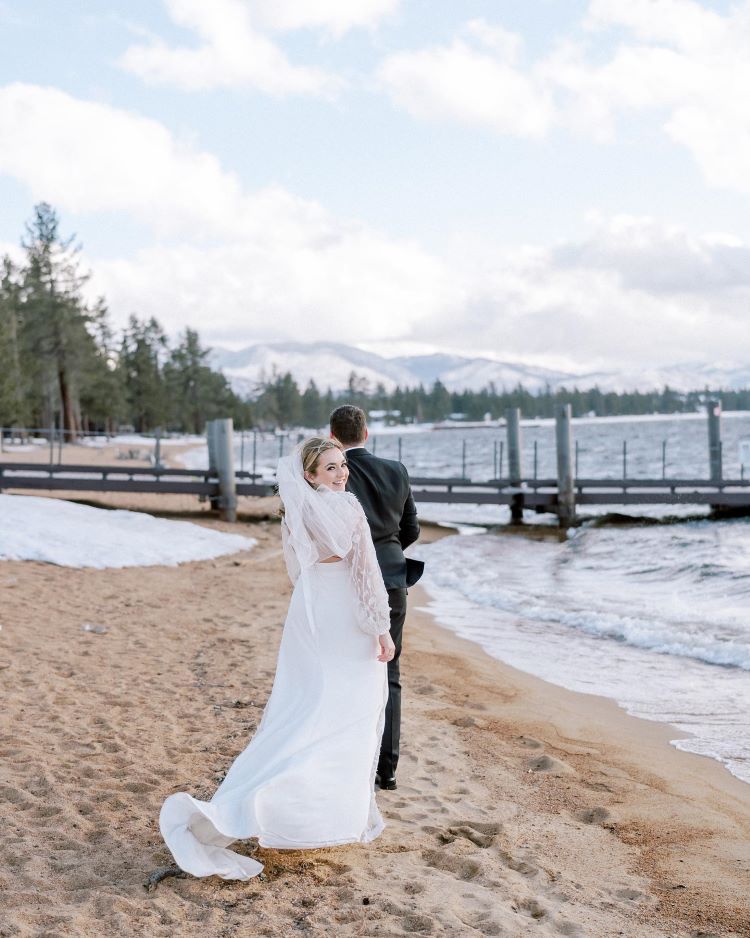
Photo by Corey Fox Photography
Common Questions About Wedding Etiquette
There are a lot of little details that come up along the way—some expected, some totally random. That’s why we’re here to cover some of the most common things couples, wedding parties, and guests tend to ask—so you’re not left guessing!
For the Couple
When should we send out Save the Dates and invitations?
Send Save the Dates 6–8 months before the big day (or up to a year in advance for destination weddings). This gives guests plenty of time to make travel plans. Invitations should go out about 8 weeks before the wedding to give people time to RSVP and finalize logistics.
Is it okay to have a child-free wedding?
Yes—it’s your call. Just be clear and respectful when communicating your preference. Mention it on your website and include wording on your invitation or details card so parents can plan ahead.
Can we ask for cash or honeymoon fund contributions instead of gifts?
Absolutely. It’s becoming more common to ask for cash or honeymoon contributions. Just make sure to include that info on your wedding website, not the invitation. Services like Zola or Honeyfund make this easy.
Do we need to invite everyone to the rehearsal dinner?
Nope. The typical guest list includes immediate family, the wedding party, and sometimes out-of-town guests. If you want a more laid-back vibe, feel free to keep it small or make it a casual gathering.
How soon after the wedding should we send thank-you cards?
Aim for within 2–3 months post-wedding. For gifts received before the big day, send thank-yous within two weeks. Handwritten notes go a long way and can be short and sweet.

Photo by Diana Galay Photo
Can we skip some traditional elements like the bouquet toss or cutting the cake?
Totally. If something doesn’t feel like “you,” there’s no rule that says you have to include it. Do what fits your vibe and skip what doesn’t.
Do we need to provide transportation for guests between venues?
Not required, but super helpful—especially if your ceremony and reception are far apart or in areas with limited parking. If you do offer transportation, make sure details are clearly shared on your website.
For the Wedding Party
What costs am I expected to cover as a wedding party member?
You’ll usually be expected to pay for your own attire and travel and possibly chip in for pre-wedding events like the shower or bachelor/bachelorette weekend. If you’re unsure, ask the couple what they’ve planned to cover.
Do I need to attend every pre-wedding event?
Not necessarily. Life gets busy, and most couples understand that. Just try to prioritize the most important ones (like the rehearsal and main events), and be communicative if you can’t make something.
Can I bring a date if I’m in the wedding party?
Only if your invitation says you can. It’s easy to assume a plus-one comes with the role, but it’s up to the couple. If it’s unclear, just ask—it's better to check than to bring someone unexpectedly and put the couple in a tough spot with seating or meals.
Do I have to give a gift if I’m already spending money on the wedding?
That is a totally fair question. Being in a wedding party comes with extra costs—outfits, travel, pre-wedding events—but a gift is still a kind way to celebrate the couple. It doesn’t need to be big or pricey. Many wedding parties pitch in on a group gift, so no one feels stretched too thin.
What are the specific roles of the maid of honor and best man?
Think of these two as the couple’s go-to support system. They’re usually involved in planning pre-wedding events, managing the timeline, offering emotional support, and giving a toast at the reception. They’re also the people to help smooth out any hiccups behind the scenes.
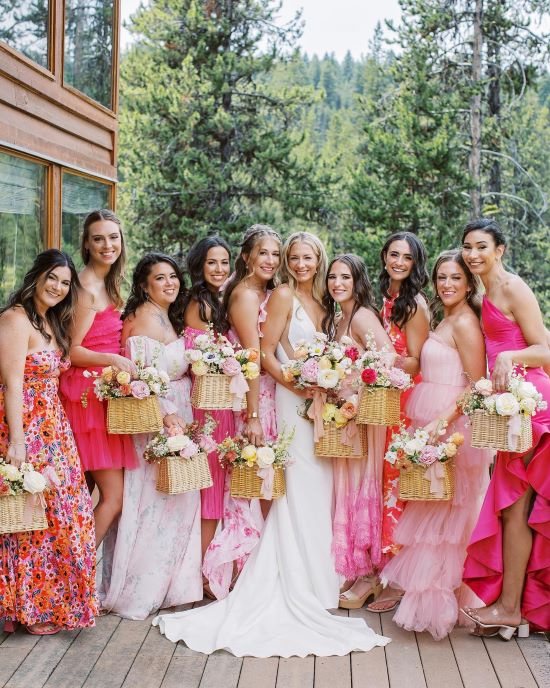
Photo by Anna Perevertaylo Photography
What if I can’t afford everything the couple is asking for?
It’s okay to be honest. Weddings can get expensive, and not everyone has the same budget. The best thing to do is talk with the couple early so expectations can be adjusted. Most will be understanding and would never want you to feel stressed or overwhelmed.
Am I expected to make a speech or toast?
Not unless the couple asks you to. If you’re feeling unsure or nervous about public speaking, it’s totally fine to bring it up ahead of time. The couple may have someone else lined up, or they might appreciate knowing in advance so they can plan accordingly.
For the Wedding Guests
When should I RSVP—and what happens if I miss the deadline?
RSVP by the date listed—usually 4–6 weeks before the wedding. If you miss the deadline, the couple might have to guess if you're coming (which can mess with seating and catering), so try to respond on time.
Can I bring a guest if my invitation doesn’t say ‘plus one’?
If your invitation doesn’t specifically say you have a plus-one, plan to attend solo. It might feel awkward, but guest lists are often based on headcount, budget, and venue capacity. Bringing an uninvited guest can throw things off, especially for seating and meals. If you're unsure, it's totally okay to check with the couple.
What’s the appropriate amount to spend on a wedding gift?
There’s no magic number—it really depends on what you're comfortable spending. Some guests use the “cost of your plate” rule as a rough guide, but it’s not a requirement. What matters most is the thought. A meaningful, personal gift (or even a heartfelt card with a small cash contribution) can go a long way.
What do I wear if there’s no dress code mentioned?
No dress code? Take cues from the invite design, venue, and time of day. For example, a beach wedding likely means casual or semi-formal, while an evening ballroom wedding calls for something dressier. When in doubt, lean slightly more formal—and skip white or anything close to it.
What’s the etiquette around dietary restrictions?
If you have a dietary restriction, the RSVP card or wedding website may give you a spot to mention it—definitely take that opportunity. Most caterers can accommodate common allergies or preferences, especially if they know in advance. If you’re worried, you can also politely reach out to the couple.
Is it okay to leave the reception early?
If you need to duck out early, aim to stay at least through dinner and the key moments like toasts or first dances. Once the party’s in full swing, it's easier to slip out without being disruptive. Just try to say goodbye to the couple—or send a message later to thank them.
Can I wear white or off-white if it’s not a bridal gown?
Even if the dress isn’t a bridal style, wearing white can feel like a gray area—and might cause confusion or take attention away from the bride. To keep things easy and avoid any awkwardness, it’s best to choose another color. There are plenty of beautiful options that won’t risk upstaging anyone.
Wedding Etiquette Made Easy
Weddings come with a lot of moving parts, but etiquette doesn’t have to be complicated. It’s really just about being kind, clear, and considerate—no matter your role in the day. But don’t forget, what really matters is the love, the laughter, and the people who made the day special. So take a breath, go with the flow, and enjoy the moment—it really does fly by!
And if you’re looking for little ways to make the whole thing feel more pulled together—from invites to your website to your thank you cards, Minted has plenty of thoughtful details to help along the way!






